Catalog Ads for Campaigns & Sales
February 14, 2024
.jpg)
Campaigns are already a big part of eCommerce advertising, so it's super important to integrate them into your Catalog Ads!
Catalog Ads are so effective at driving sales that you are missing out if you only promote your campaign with non-dynamic content. Ideally, you will have to integrate the campaigns into your entire marketing mix, including your Catalog Ads.
It helps to synchronize your funnel so that the content in your customer journey, from your top-funnel ads to your bottom-funnel Catalog Ads, all look the same.
Even though sales more often than not will perform better, then sales are especially effective in your bottom funnel and retargeting - making consumers that already know about you very likely to buy.
The more bottom-funnel your ad is, the better a sale will work.
- Top-funnel ads see a +39% improvement in Return on Ad Spend when showing on-sale designs
- Bottom-funnel ads see a +68% improvement in Return on Ad Spend when showing on-sale designs
It might seem like a big task, but if you use a tool like Confect, you can easily control your Catalog Ads and create designs for all your products - you can even schedule campaign designs to change in the future!
Table of contents
Important Campaign Periods
One of the biggest topics when discussing campaigns is campaign periods. Your audience almost always knows these are coming; in fact, in many cases, they are waiting for them!
Campaign periods can be many things, but in general, they involve holidays and big events like Black Friday, Christmas, Eid, Valentine's Day, and so on.
Chances are you have already run some campaigns during these periods, and you should most definitely include these in your catalog ads.
Below, we've collected some of the best examples of Catalog Ads for campaign periods. Use them as inspiration for your own!
Catalog Ads for Black Friday
There are many approaches to making Black Friday designs for Catalog Ads. The most important factor is probably buying into the Black Friday theme.
Your audience will be waiting for those Black and Yellow or Black and Pink designs! It's almost common knowledge that ads like these are Black Friday ads. Use this to your advantage, and make sure no one is in doubt that you are promoting a great Black Friday offer!
In fact, this is important throughout all campaign periods - you have to make sure you synchronize the catalog ads with your other marketing content and what your audience is expecting!

The above example from PrettyLittleThing looks like a Black Friday design; there's absolutely no doubt about that. Another genius thing they are doing is that it resembles their normal Catalog Ad layout 1:1.
This is not by coincidence. It's important to ensure that your brand is still recognizable even though you might not be using your brand colors or usual elements.
Your ad may look the part, but it's equally important to include the correct information.
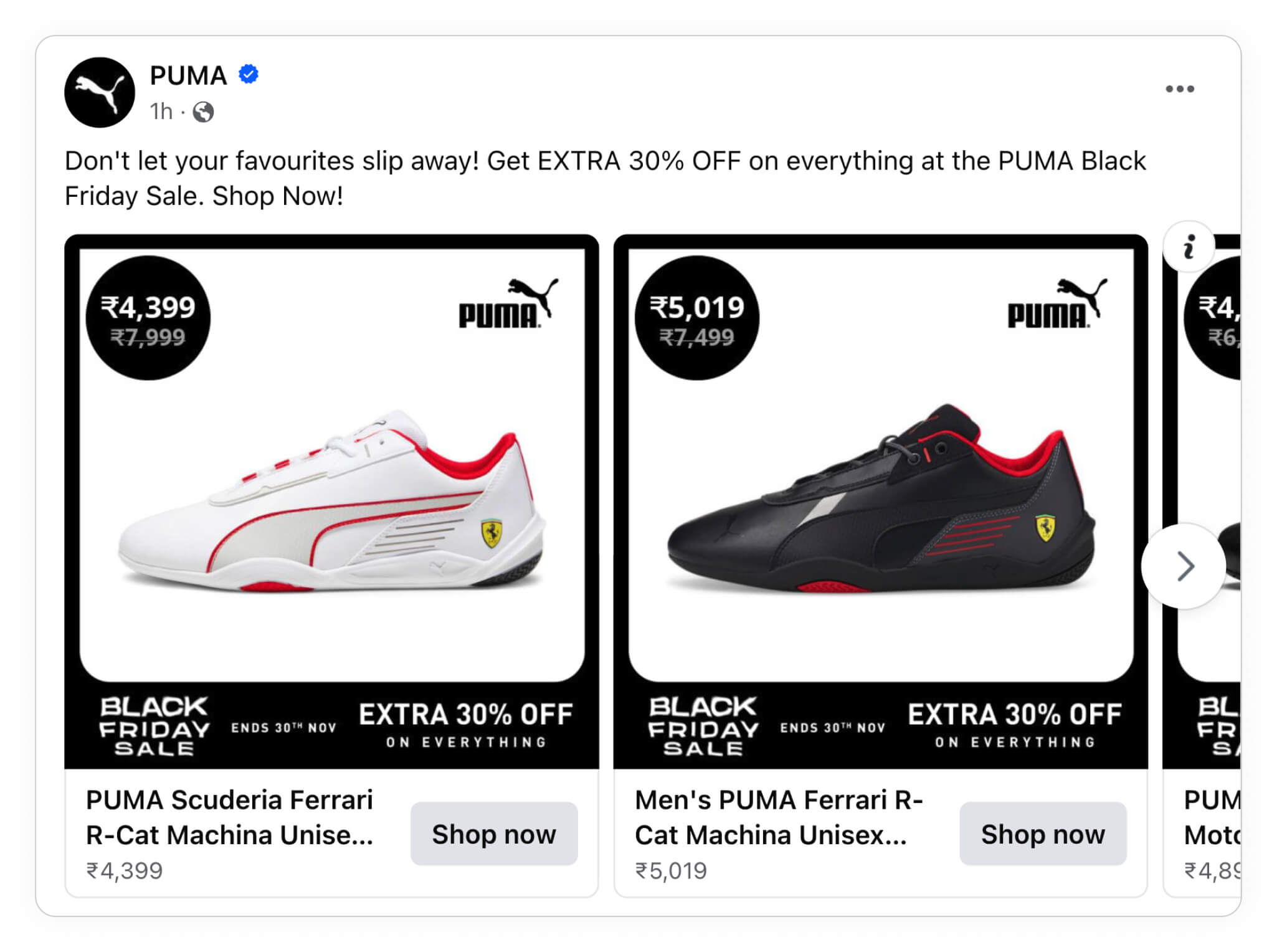
This ad from PUMA is also easy to spot; It's a Black Friday ad, but they are focusing more on including as much information about the sale as possible - compared to the ad before.
They include the price, their logo, the savings, the end date of the sale, and the fact that it's a Black Friday sale. This is a lot of information, but it is almost also everything the buyer might need to make a decision. It's an extreme case, but it is definitely worth considering including as much information as possible.
The more affordable prices you have, the better savings and discounts typically perform in your Catalog Ads.
- Affordable shops see a +115% improvement in Return on Ad Spend when showing savings and discounts
- Mid-end shops see a +73% improvement in Return on Ad Spend when showing savings and discounts
- High-end/ Luxury shops see a +24% improvement in Return on Ad Spend when showing savings and discounts
You can learn more about showing savings during campaigns in your Catalog Ads right here and see a lot of sales and campaign Catalog Ad examples here.

The above ad is a great example of a spin-off of Black Friday. You don't necessarily need to yell Black Friday.
A lot of advertisers choose to call it Green Friday, Pink Friday, or even Black Taiga like the above example. It really goes to show that it is possible to "invent" your own variation of Black Friday.
Cyber Monday or Week campaigns
Cyber campaigns are very close to Black Friday and usually run right after it; some people even opt to use Cyber Week instead or as a big part of their Black Friday setup.
It's a great way to continue your Black Friday campaigns and offers, just with a little twist.
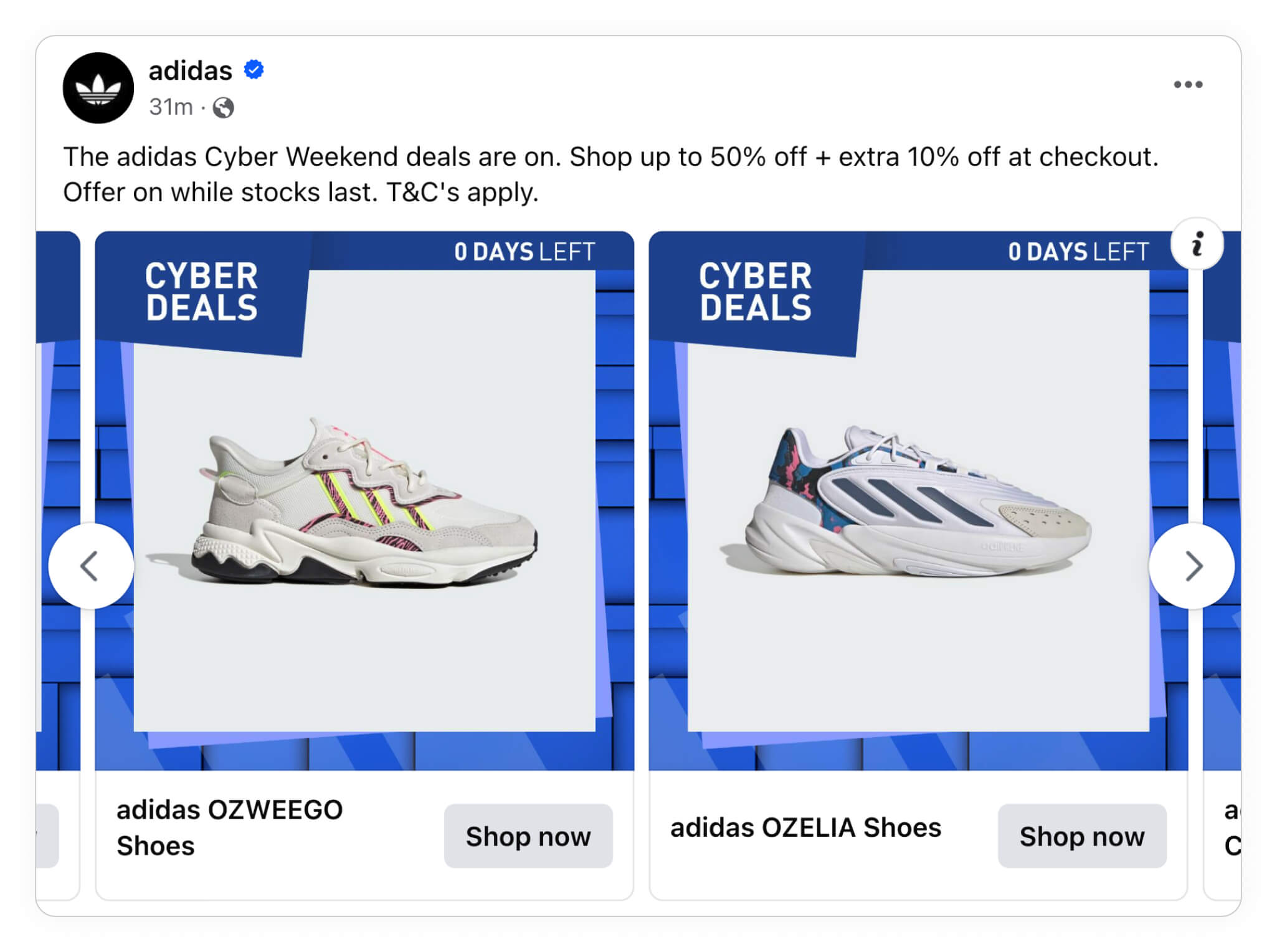
For Cyber Monday or Week, a lot of the same best practices from Black Friday apply. A lot of people expect this campaign to exist, so even just mentioning it will get you some traction
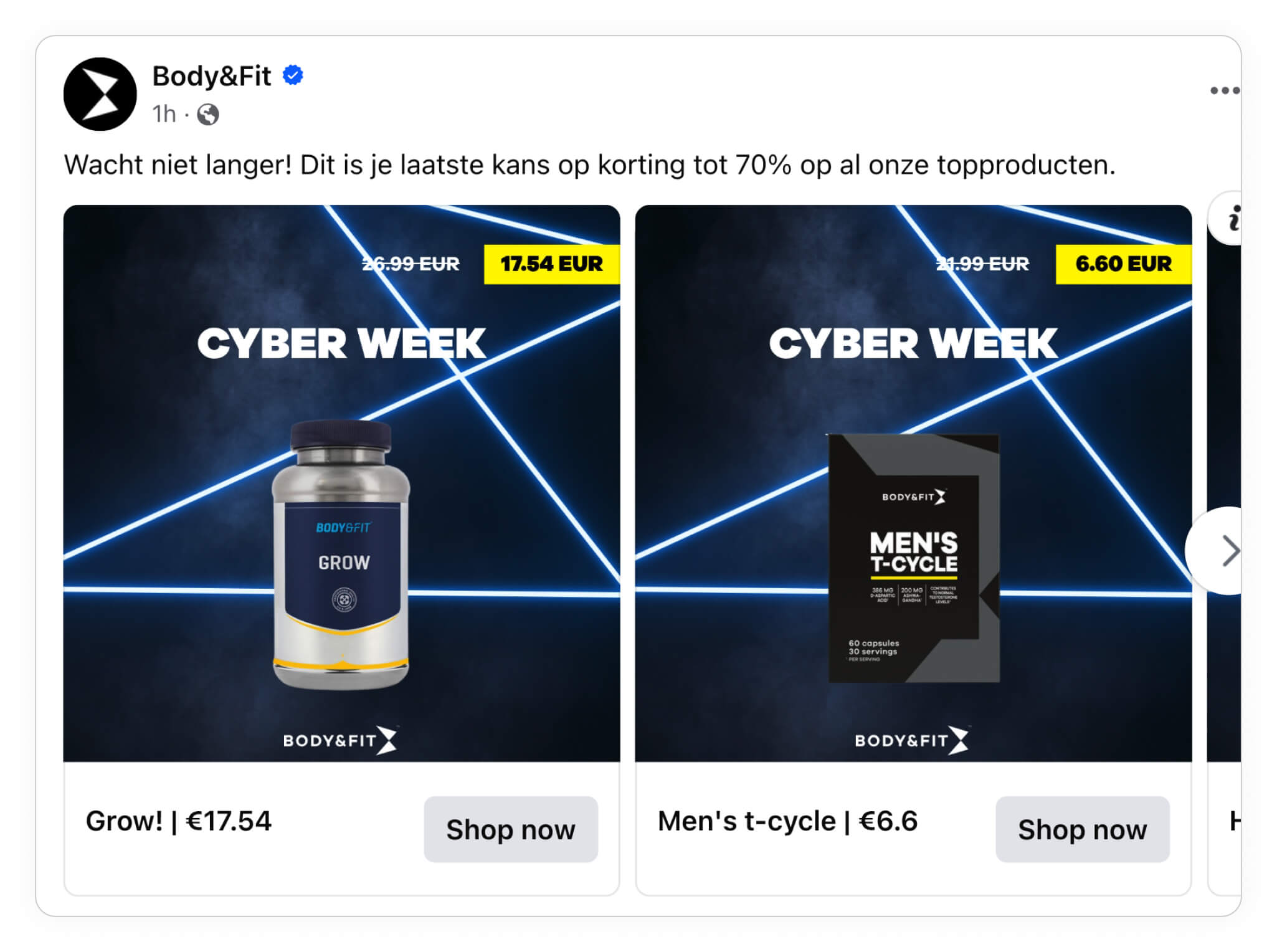
As with most sales-driven campaign periods, the price, or the reduction of the price, has to be in focus.
This is probably the number one factor people consider when buying, so be sure to show this in your Catalog Ads!
Catalog Ads for Christmas
Christmas is a huge campaign period in most parts of the Western world, and chances are you're already running some Christmas promotions.
What differentiates Christmas from other campaign periods, such as Black Friday, is that it's not necessarily the offer that's in focus; in some cases, it's more the product, your brand, or the fact that you have a great return policy!
Take a look at this ad from Pour Moi. They don't talk about a specific offer, they don't talk about a specific product
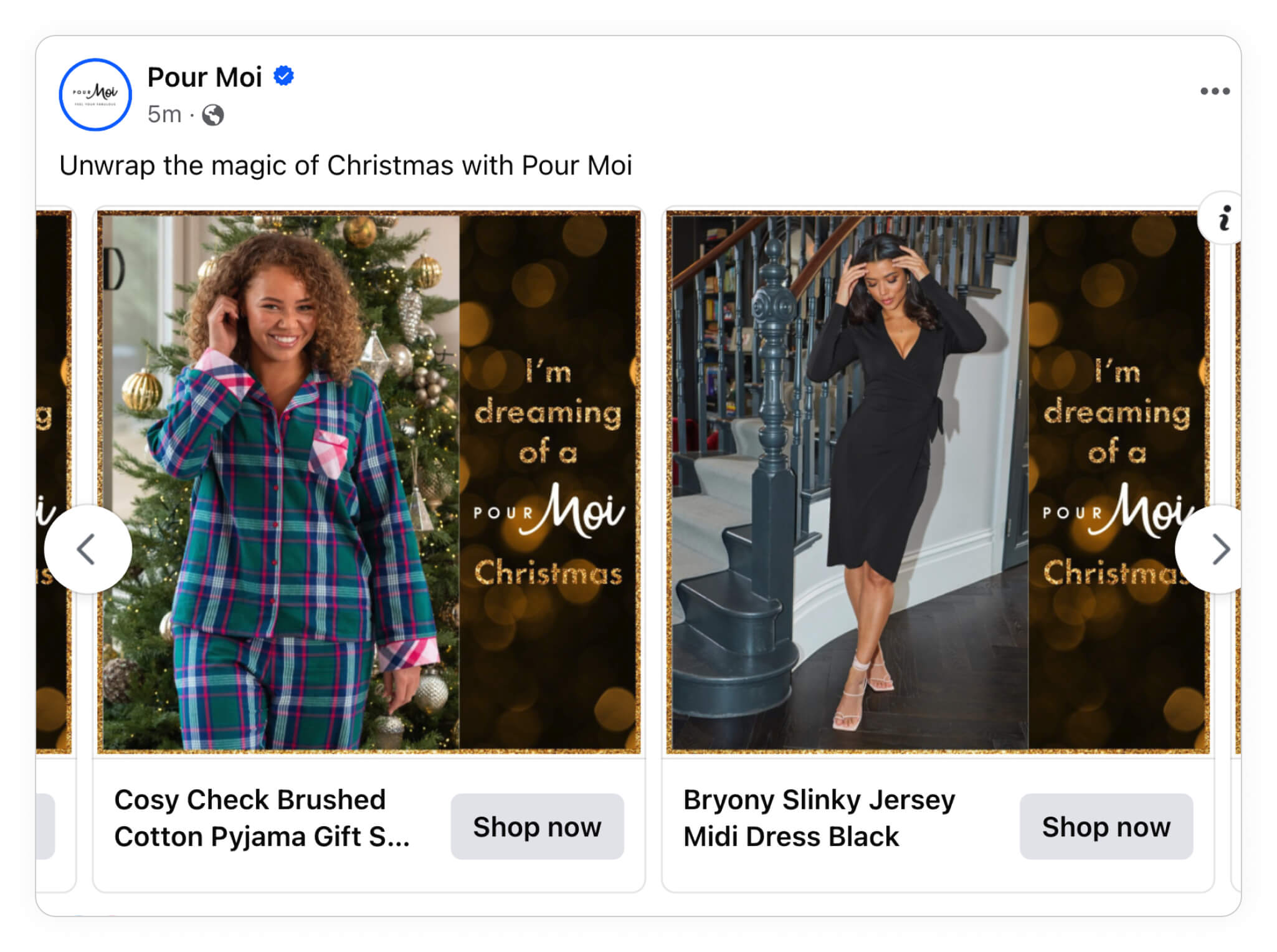
Instead, they talk about a feeling—a "Pour Moi Christmas." If you are buying a Christmas gift for someone you know who likes the brand Pour Moi, you will want to give them this feeling.
Of course, this is not the only way to run Christmas campaigns, but it is surely worth considering if you could send a message in the same style.
Going a bit more specific on the offer/promotion, you find this IKEA example.
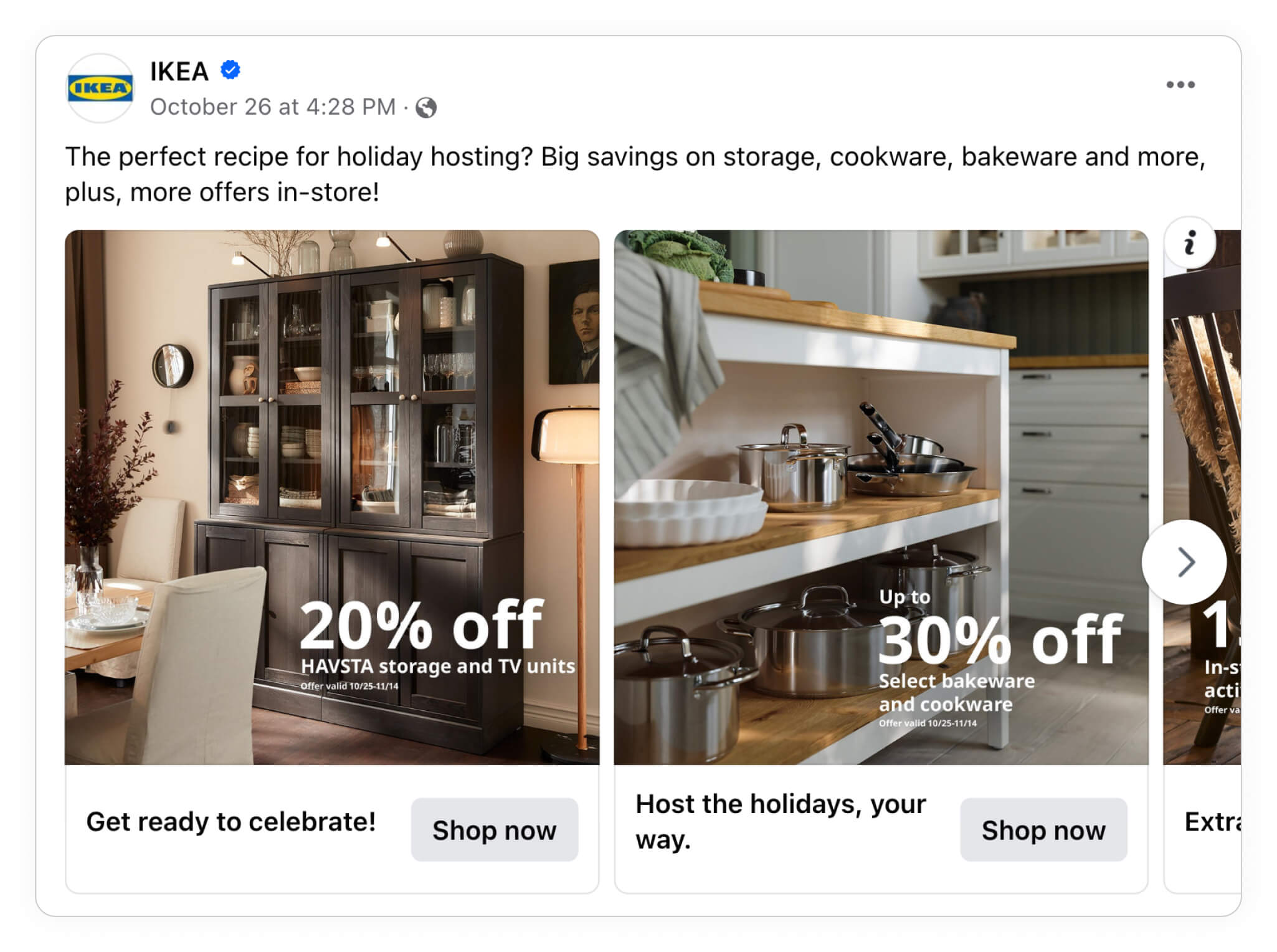
They are still not promoting a sale on each specific product, but again, they are trying to convey a broader message.
You have to prepare for the holiday season, which means you have to ensure you are stocked up on things you need in their categories.
Another great way to make your Catalog Ads a bit less sales-focused and more try to promote a feeling.
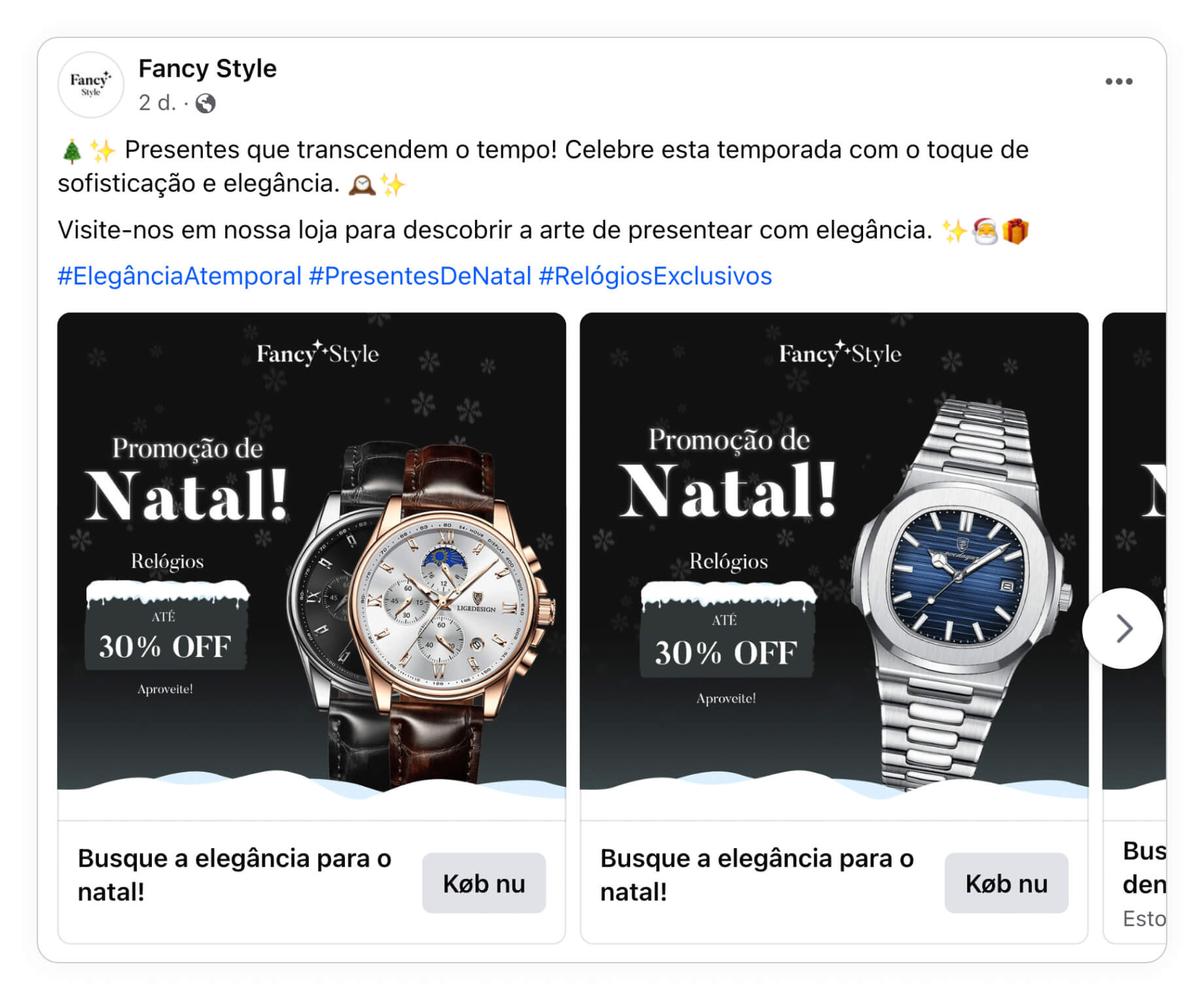
The last Christmas Catalog Ad is more focused on the sale of each product. They show the specific products and a saving - you are not in doubt that you can get a great deal here.
Catalog Ads for other Campaign Periods
Even though Black Friday and Christmas are the biggest campaign periods, there are still a lot of periods worth your time.
The good thing about campaign periods is that the learnings from one period typically apply to most if not all, periods.
For instance, this ad celebrating Eid, uses a lot of principles that would work in Black Friday as an example.
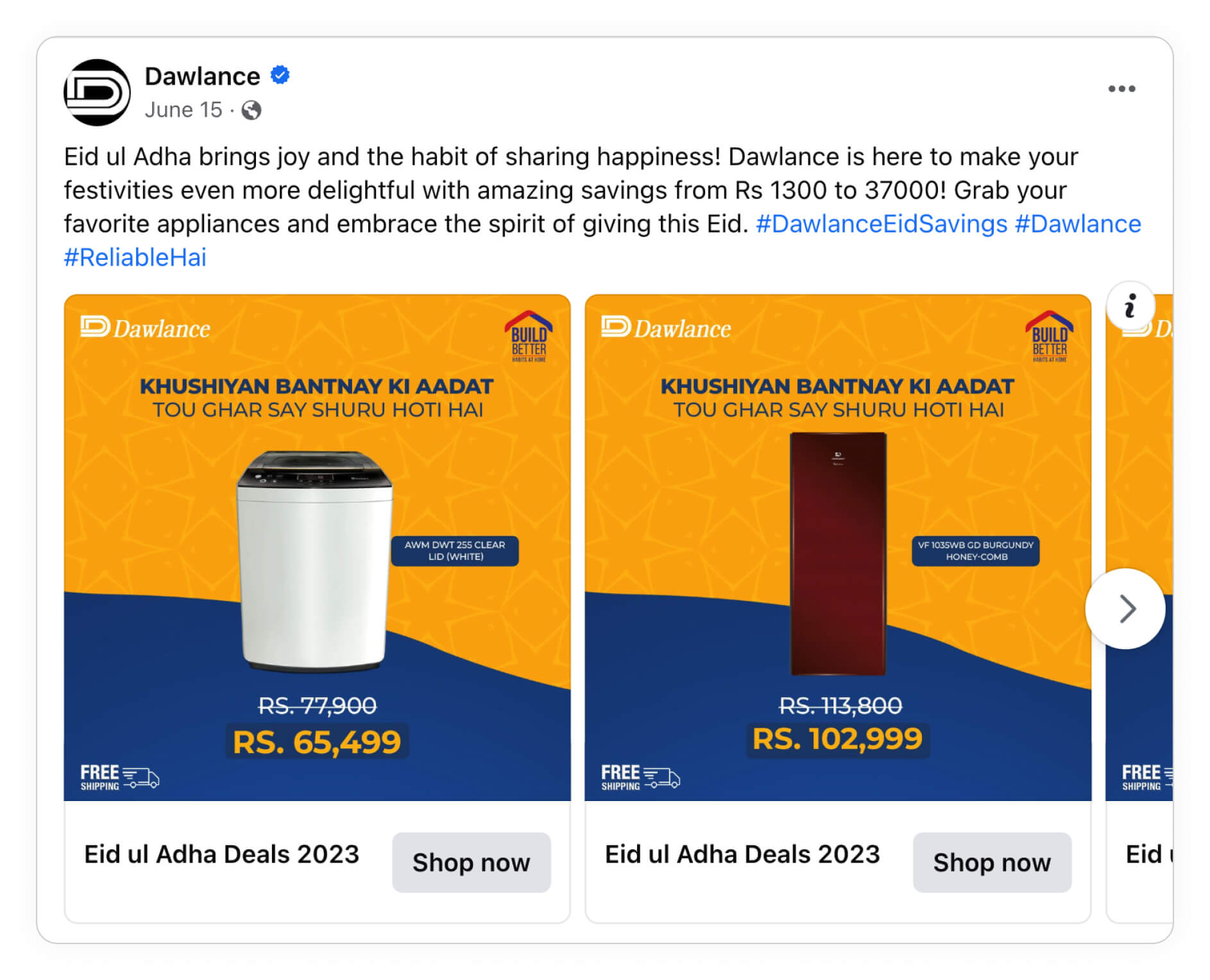
They show the price and the savings they offer for this campaign, but they also showcase their free shipping and top it off with a great campaign-themed (but still branded) background.
In essence, you can take these principles and transfer them to almost any campaign period.
Even though Valentine's Day are only a single day, there's a lot of potential in Valentine's campaigns. Take a look at this example from Samsung:
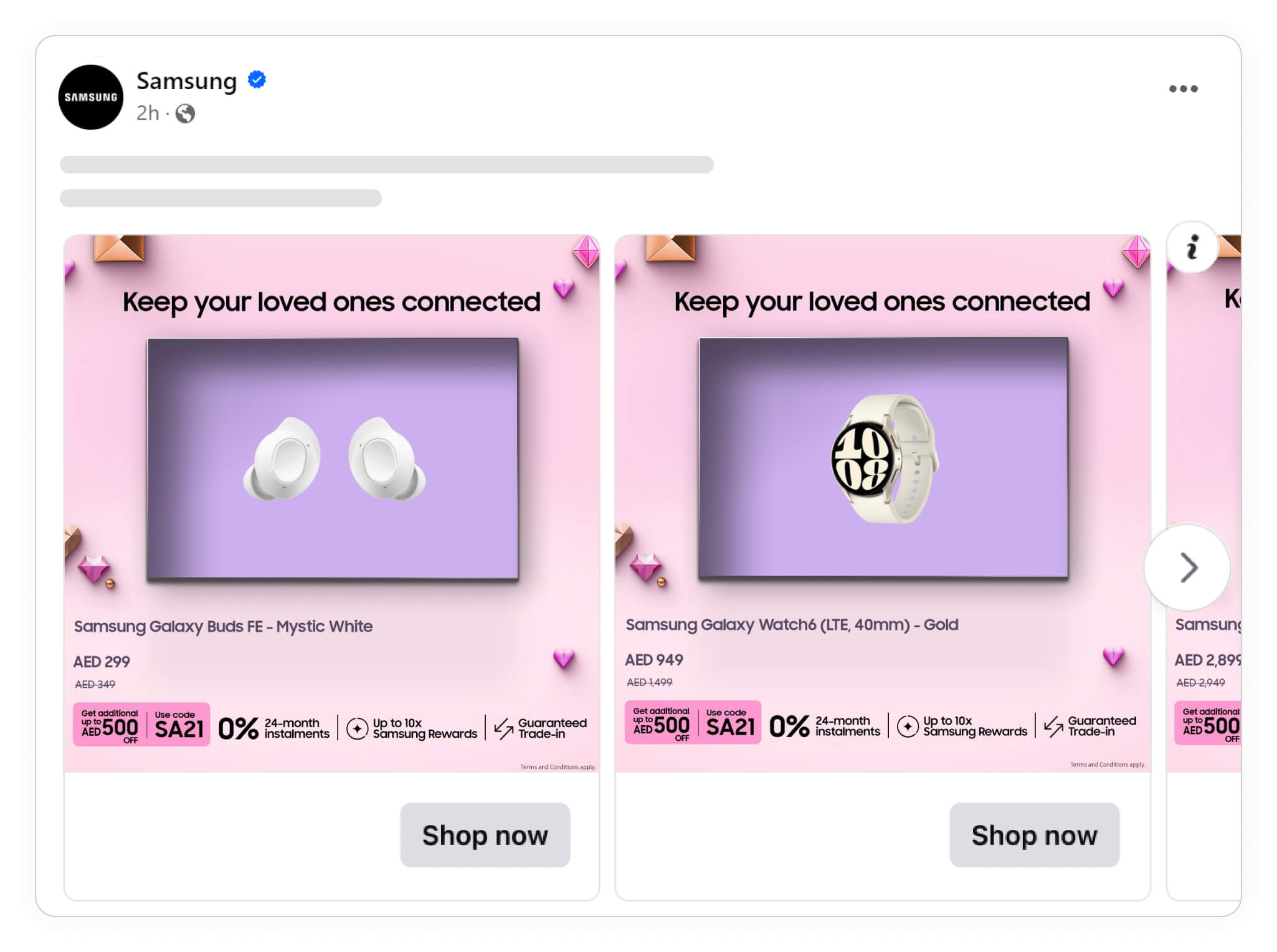
Again, here, they are really going above and beyond to make sure you connect a feeling to their campaign, "Keep your loved ones connected."
Even though they are heavily promoting that statement, they are still making sure to showcase their USPs, which, in the end, will make the buying decision easier. This is another great combination of storytelling and product-specific sales.
Time-bound/limited Campaigns
One of the most important things when talking about any campaign is the ability to build urgency.
It's why we do campaigns and why campaigns are so effective as they are. They limit the offer to that exact period, week, day, or timeframe your campaign uses.
Dates are especially effective for multi-brand stores.
- Brands and DTC companies, on average, don't see improvements in Return on Ad Spend when showing dates
- Multi-brand stores see a +49% improvement in Return on Ad Spend when showing dates
This sense of urgency might come easier when promoting campaign periods, as we talked about in the previous section because these periods are so widely known that the consumer is almost waiting for the period to start.
But when promoting campaigns outside campaign periods, you must be more creative in creating urgency.
Weekly campaigns
One way to create urgency in your limited campaigns is by tying it to a specific time period.
For instance, weekly deals are a straightforward way to do this. You make it clear that this promotion is only happening this week. Thus, the buyer knows they have to take the chance now!
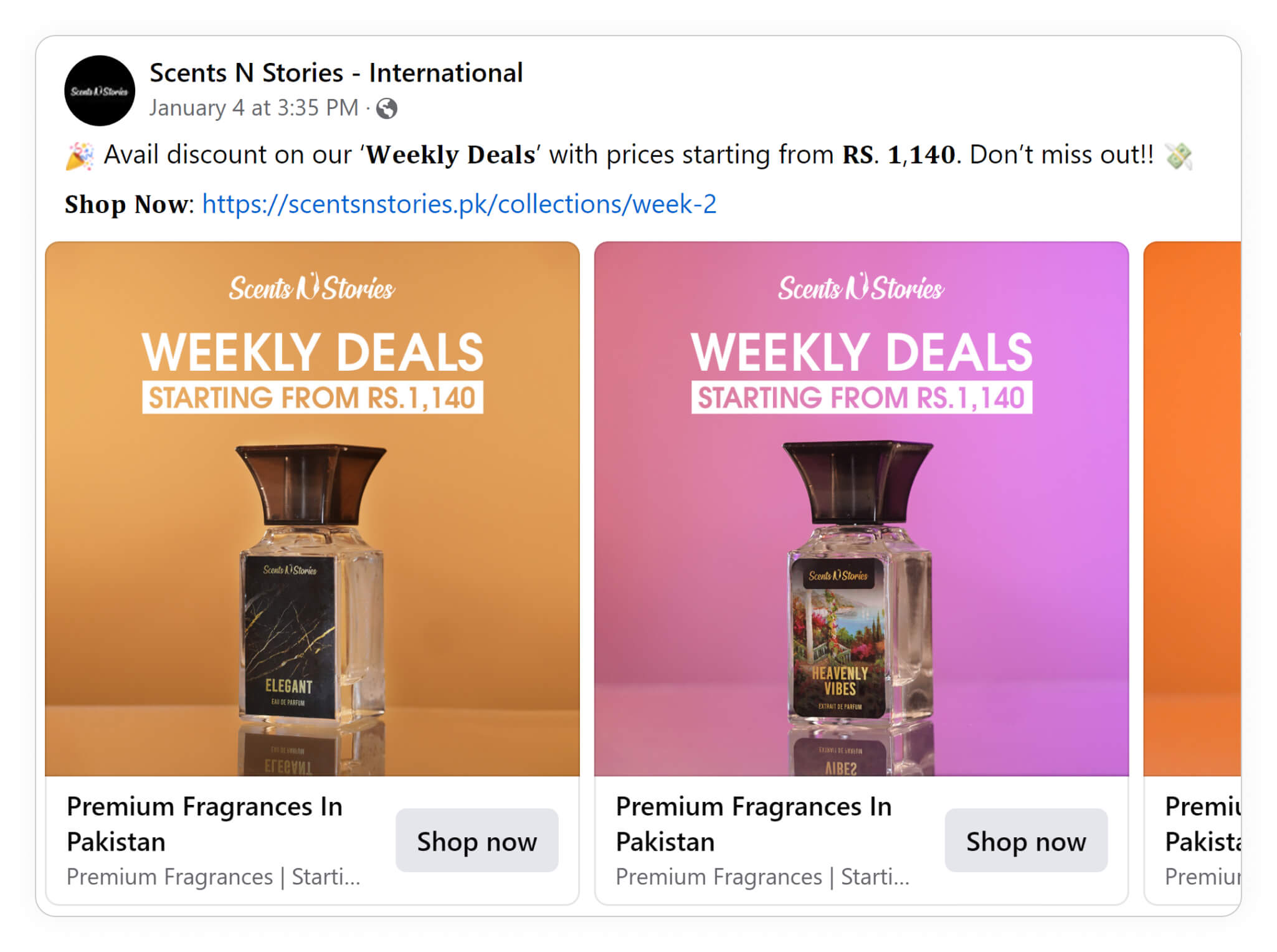
This is a great ad, and you are not in doubt that this is only a weekly deal - the ad screams it!
Another way to do weekly campaigns is to combine them with other periods or holidays happening simultaneously. For instance, in the ad below, they've turned International Women's Day into Women's Week.
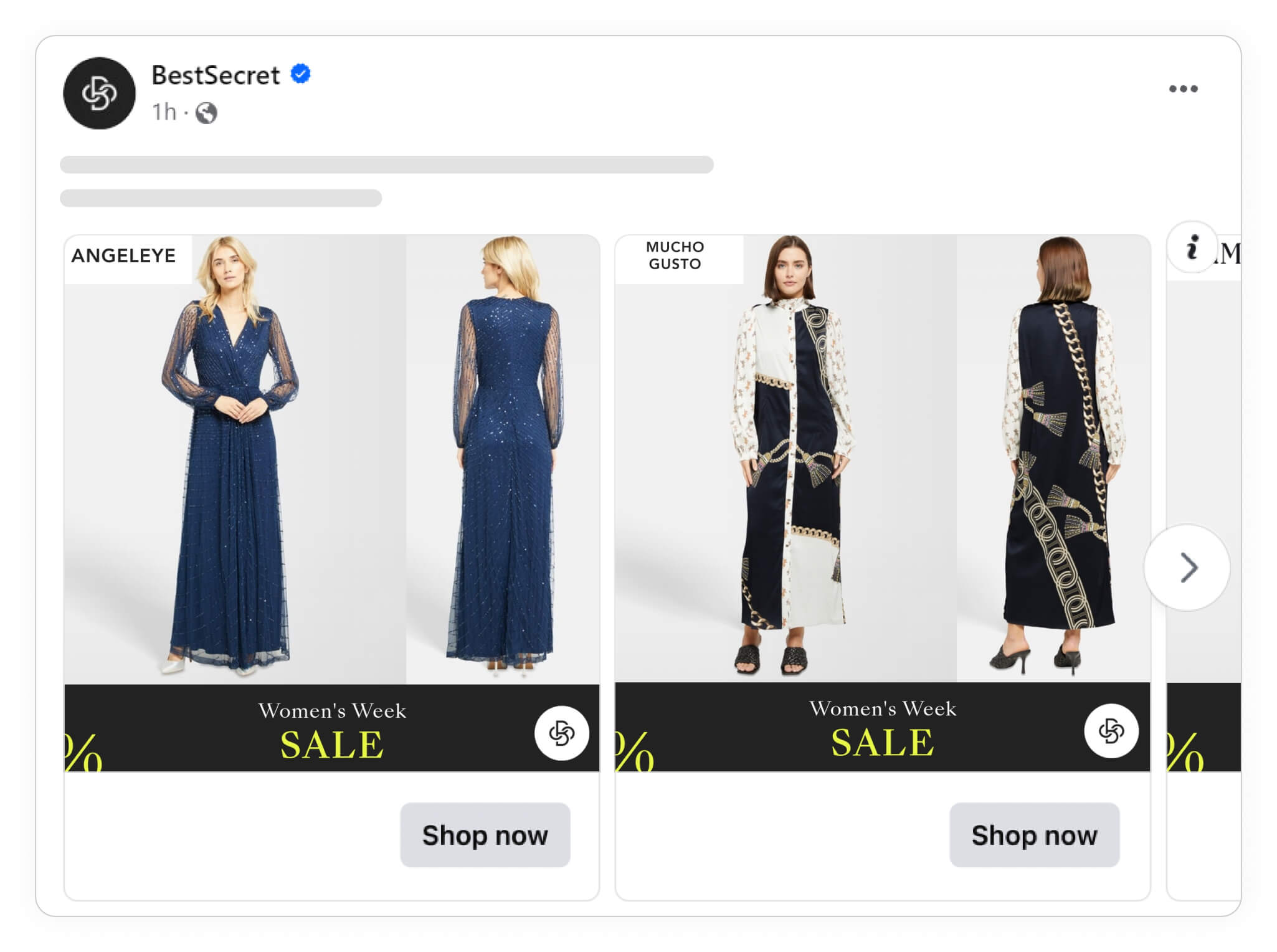
Here, the ad ties the promotion to something bigger and perhaps more meaningful, which makes the offer more compelling.
Another great way to promote weekly deals is to utilize your brand and make it a clear concept that this week is about your brand, and it's now you have to check out this promotion!

This ad from Bose does this perfectly. They created the concept "Bose Week," which immediately makes buyers that have some connection to Bose interested - while combining it with the sense of urgency that a weekly deal creates so well.
Savings and discounts are almost always good ways to make people buy, but it's interesting how they are a bit more effective for the brands themselves than for multi-brand stores.
- Brands and DTC companies see a +73% improvement in Return on Ad Spend when showing savings and discounts
- Multi-brand stores see a +54% improvement in Return on Ad Spend when showing savings and discounts
You can learn more about showing savings and discounts in your Catalog Ads here.
To sum up, weekly deals create a strong sense of urgency that is easy to convey and understand, but if you really want to go all in, there are huge possibilities for that as well—by tying it to something bigger or utilizing your brand and following.
Special occasions
It's not everything that accounts for a weekly or even longer time-bound campaign. Sometimes you might want to celebrate a special occasion!
The good thing about special occasions is that you decide how long the campaign will run. And you don't even have to get specific about the timing in your content because it's not really what matters here. What matters is the occasion.
For instance, this ad from Lekker Bikes celebrates that it's a new year and that you need a new bike!
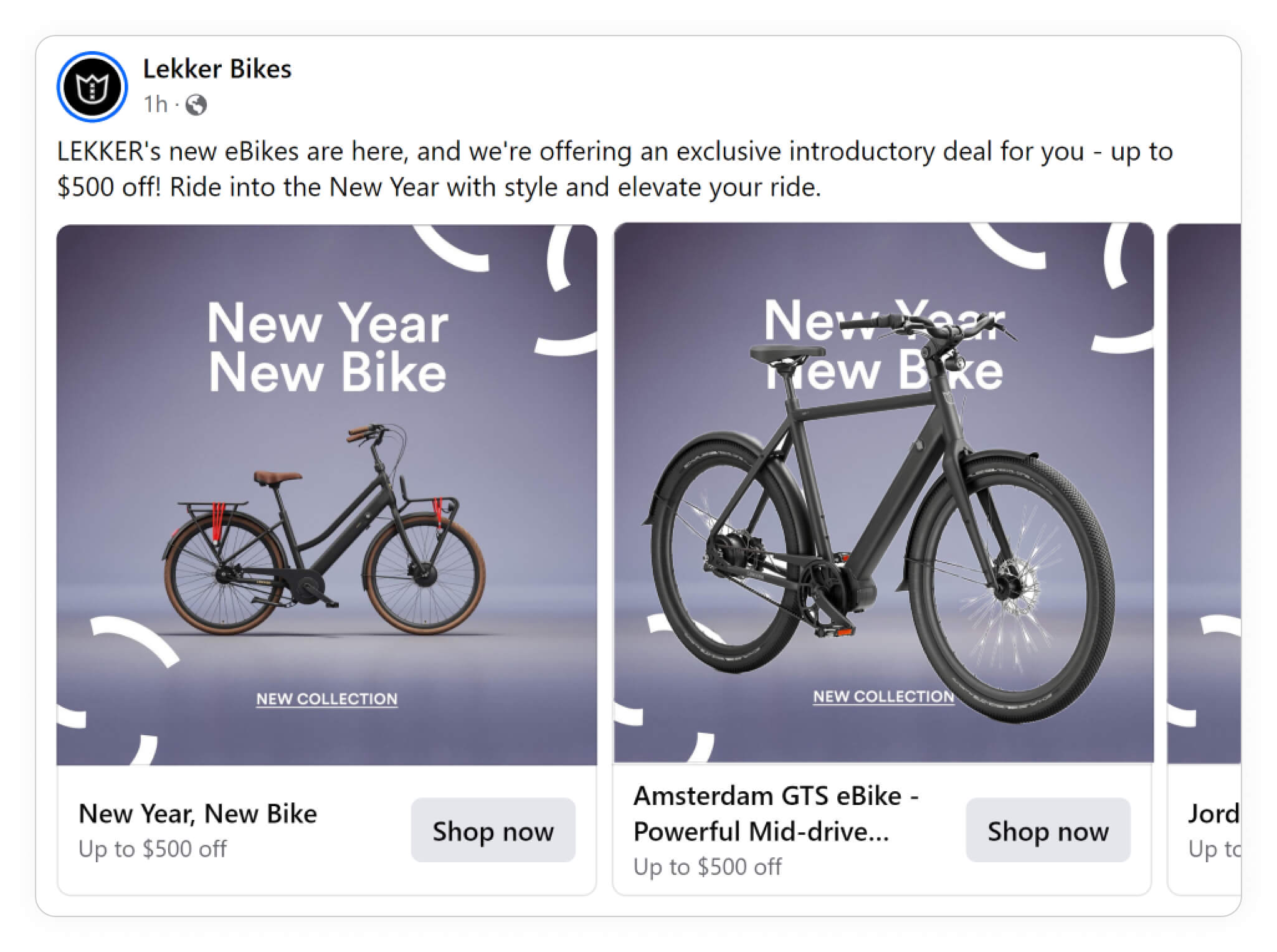
This Catalog Ad campaign tactic is genius because it's something most people can relate to. It's a new year, so I might need to treat myself to a new bike!
What's even better is that you can essentially run this campaign for a good portion of January, and people will still think the same—of course, the urgency will be bigger the closer to the new year, but it still exists at the end of January or February for that sake.
Another tactic could be to celebrate something that happened to your brand. A new product launch, a milestone hit, or a birthday.
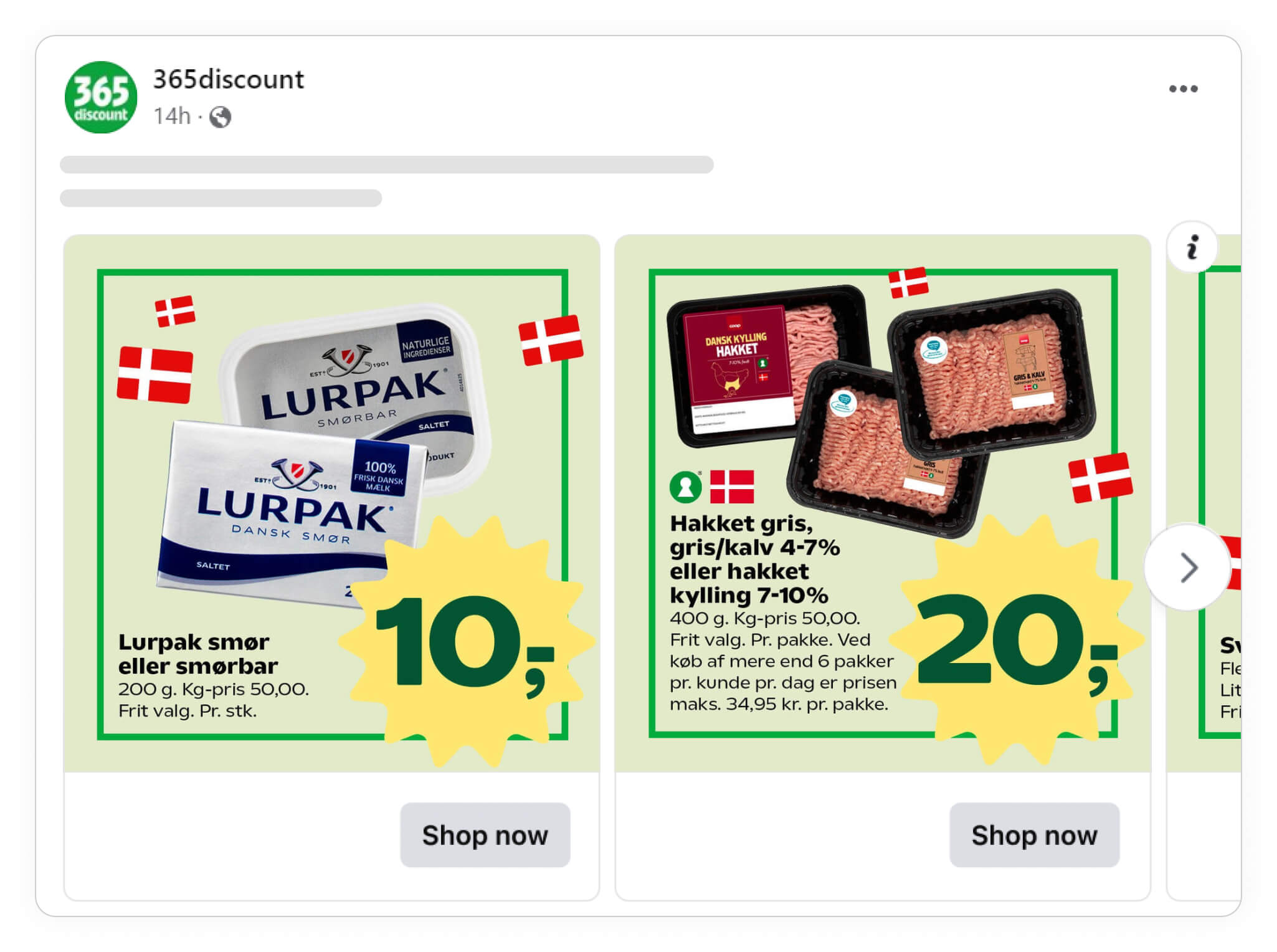
When doing limited campaigns that are bound to something about your brand, the urgency might not hit as broadly as a "new year" campaign, but it will still be huge for fans of your brand!
Sharing your success with your audience is a great practice, and if you can tie this to something urgent, like a limited campaign, it's even better.
Season-based campaigns
A big part of season-based campaigns could've been categorized as a campaign period, but we wanted to give it its own section as there are parts of season-based campaigns that aren't necessarily focused on the sale (as campaign periods typically are).
Before we get into that, let's take a look at some great ways to do seasonal sales.
Seasonal Sales
Seasonal Sales are probably the most common type of season-based campaigns and for a good reason. It's a great way to capitalize on buyers already looking for items for an upcoming season.
A common example is fashion brands offering discounts on either the upcoming season's clothing or the latest season's clothing.
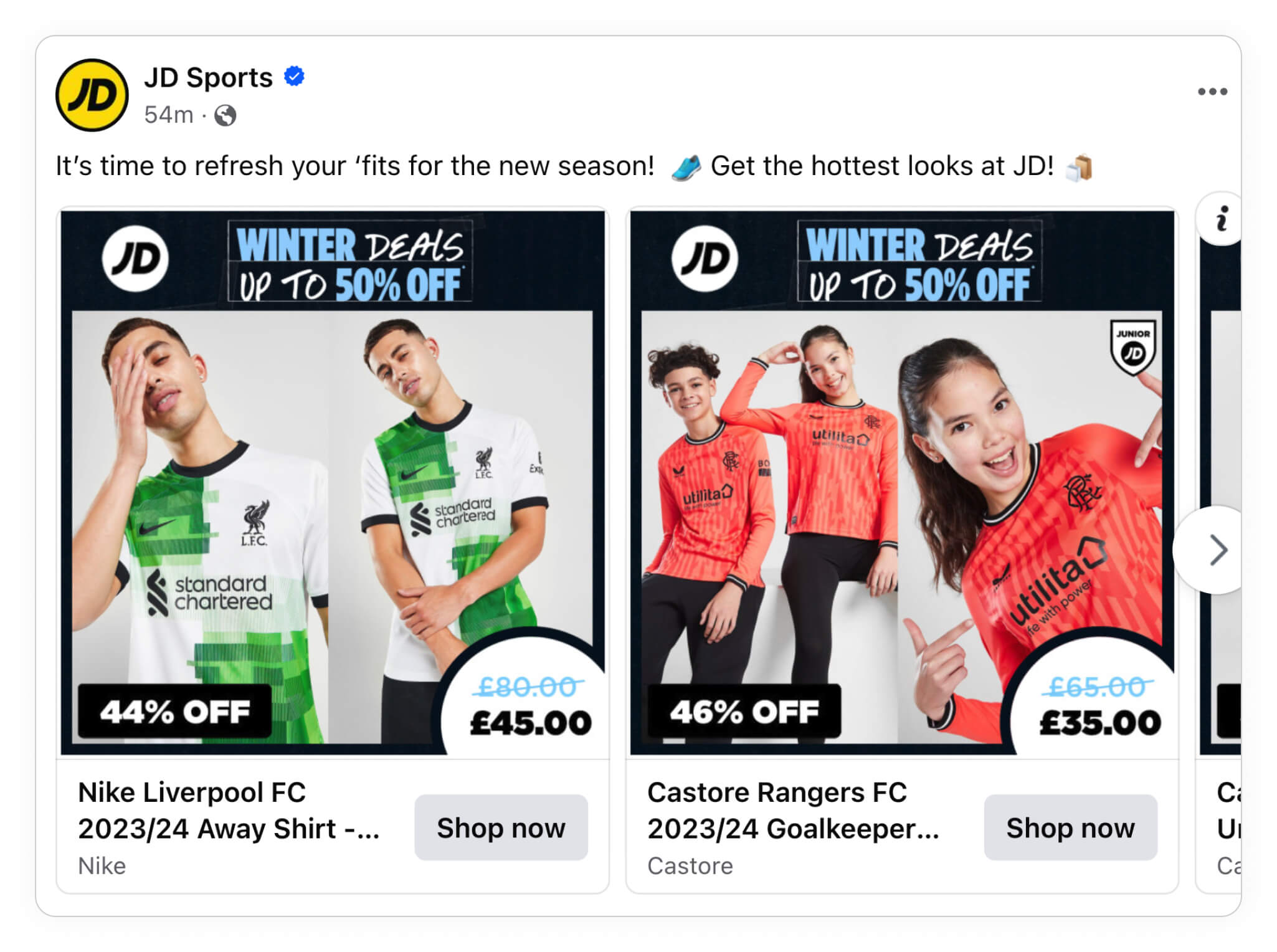
This ad from JD Sports shows really well how a campaign like this could be executed. It clearly states that it's a winter deal and uses additional images to show the product from multiple angles.
The example from JD Sports contains a lot of information about the product (multiple images, price, savings), but you don't necessarily need to include that - less can do it!
Take a look at this example. They don't include any product information; they only show that it's a summer sale.
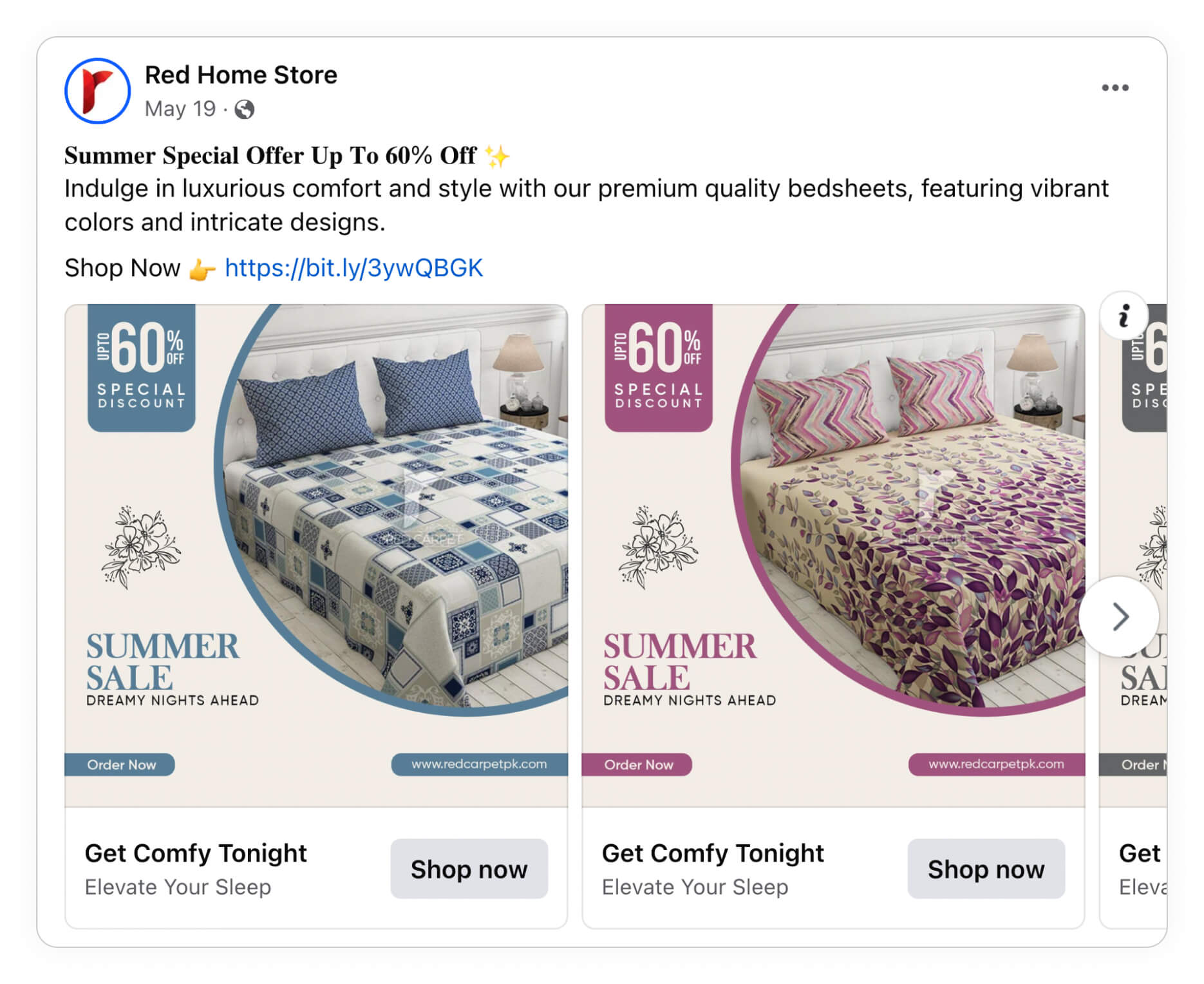
We generally recommend that you include at least some relevant product information. But if you think it fits with your brand, you can easily get by without it.
A great mix between the two, could be a solution like Garmin have opted for here. They show the relevant product information - but in a much simpler design with only a packshot.
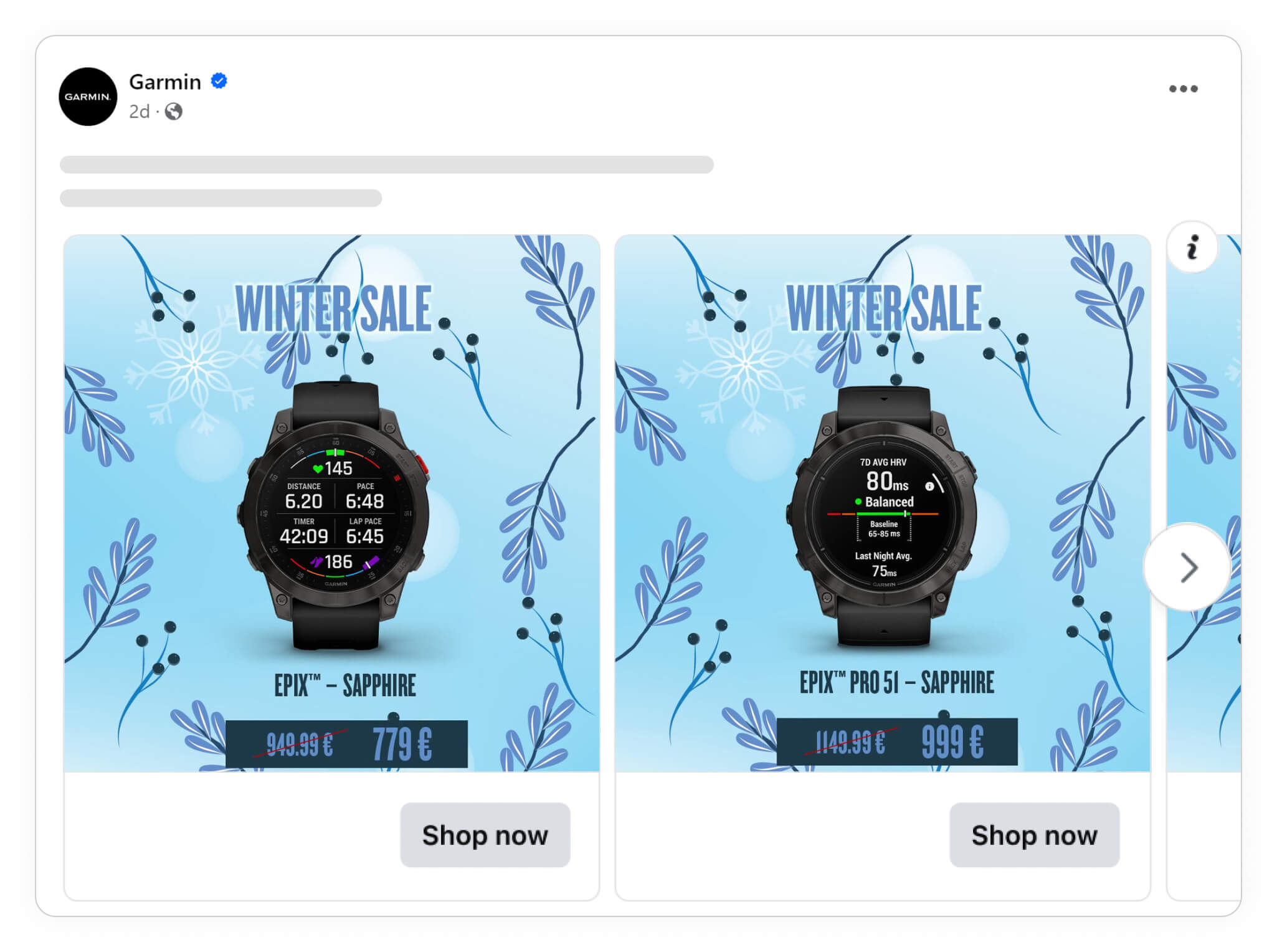
Seasonal Sales don't have to be clear about the season it's about, like the three prior examples.
Take a look at this Nike campaign. It's clearly an end-of-season sale, and we should act now, but it's not specified which season—they think it's redundant information in this case.
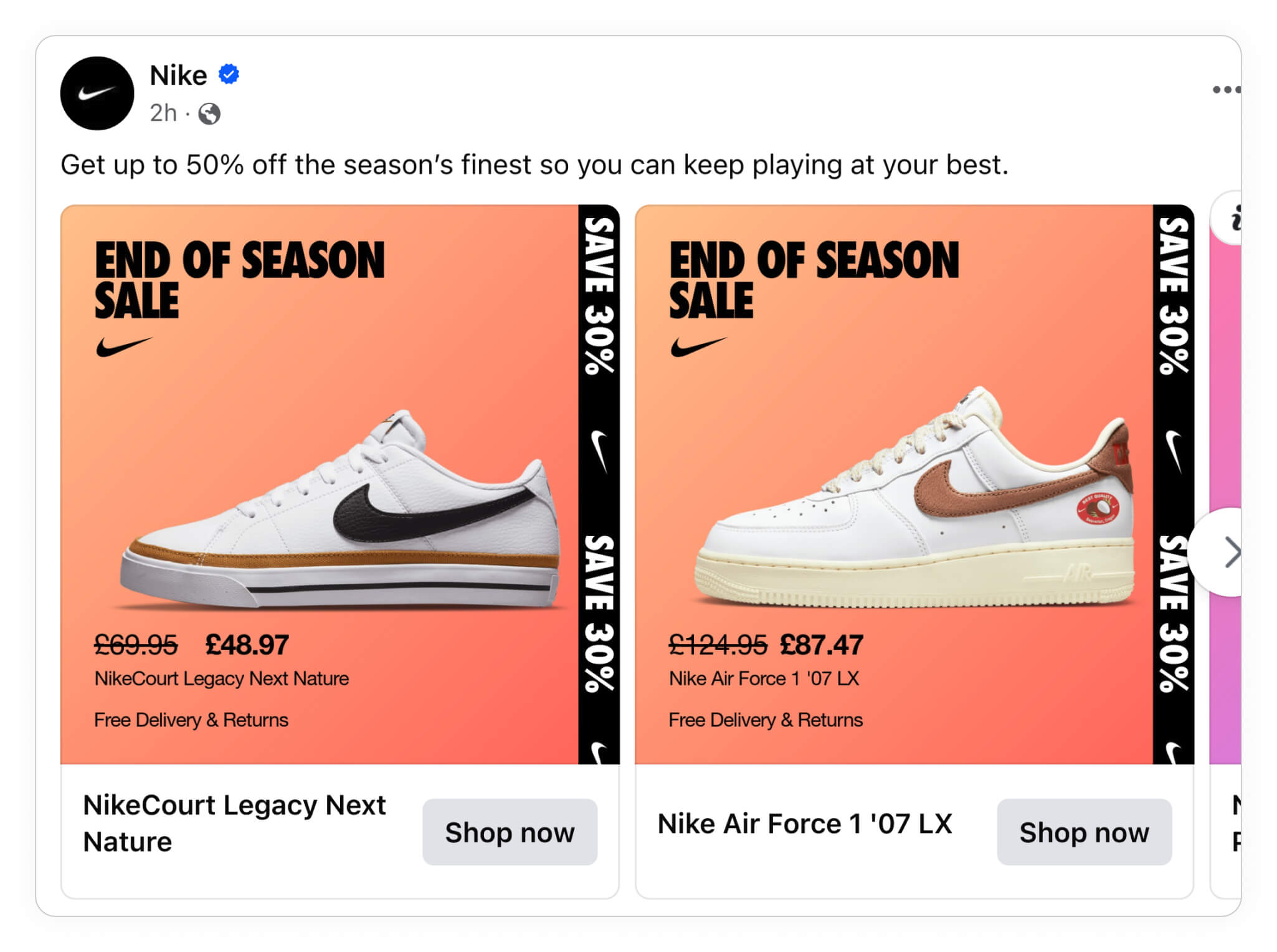
Like the end-of-season sale another great season-based campaign to consider could be a mid-season campaign.
Again, you don't have to state exactly what season we are in the middle of - and hopefully, your audience already knows which season is in progress.

If you want to make the best possible seasonal sales - or any sales for that matter - you might want to check out this article:
The Ultimate guide for showing discounts in Catalog Ads
Seasonal product highlights
It's, of course, not only sales that can be season-based; campaigns that showcase products for a specific season can be just as urgency-filled.
Take a look at Ralph Lauren's "Wardrobe Refresh" campaign; it's a great way to introduce products for the new season.
.jpg)
It's a simple design, but that helps the campaign—we even felt the urge to refresh our wardrobe when picking this campaign.
This ad from GANT is another Catalog Ads campaign that follows the same principle—but is a bit more direct.
This ad doesn't leave much to the fantasy; they want you to see their best products for the season.
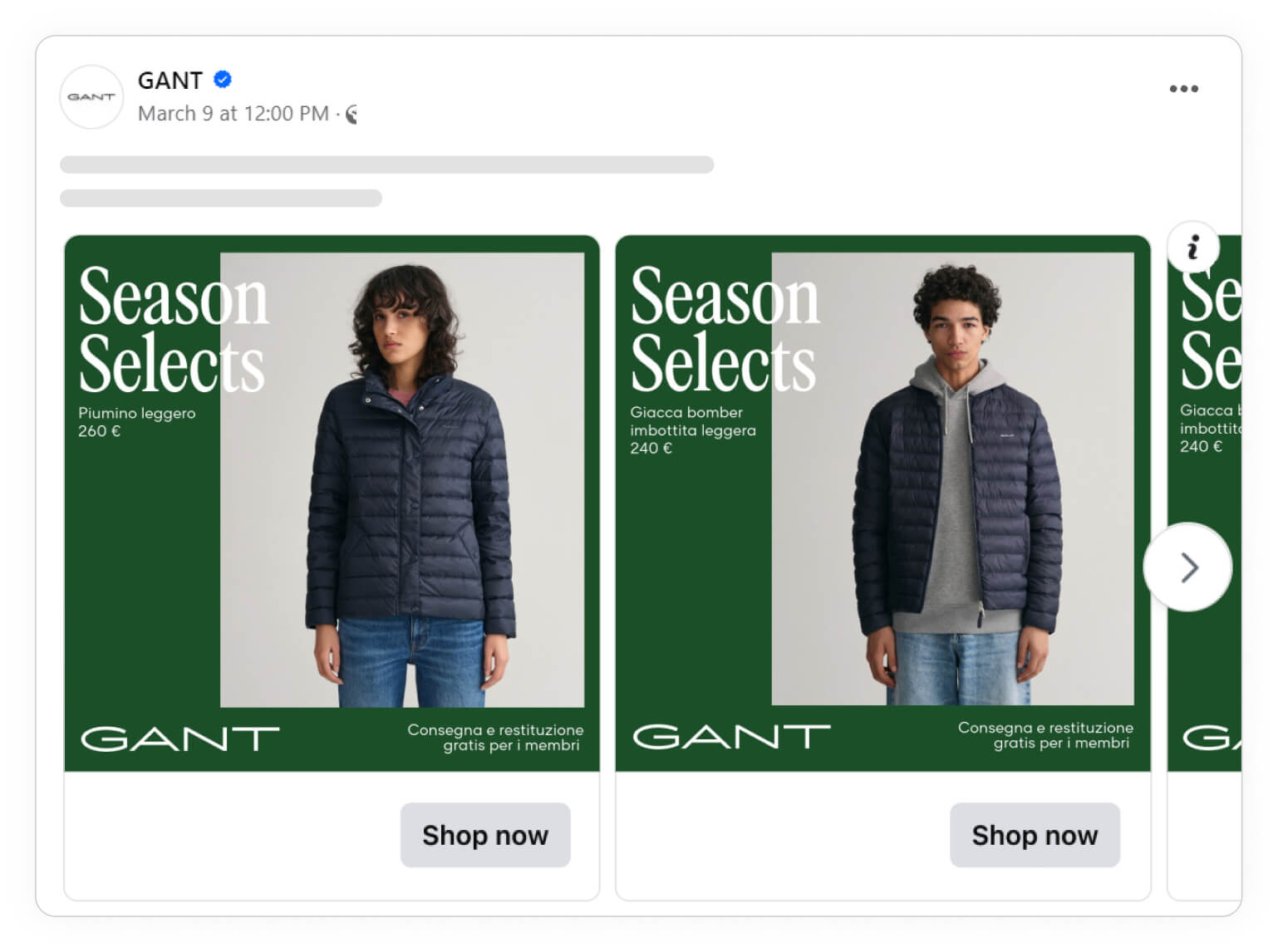
These two ways to do Seasonal product campaigns might not be relevant to all brands & industries, but we are sure that you can find inspiration from them.
They are especially relevant for brands in the fashion industry. If you work in fashion, you should check out these Catalog Ads tactics for fashion brands.
Always-on campaigns & sales
The campaigns we've been through in this tactic article have all been tied to a period of time in some way—some of the examples more than others.
But there's also huge potential in campaigns that aren't tied to a time period—campaigns that you technically could run 365 days a year.
The lower prices you have, the better on-sale designs will typically perform.
- Affordable shops see a +97% improvement in Return on Ad Spend when showing on-sale designs
- Mid-end shops see a +48% improvement in Return on Ad Spend when showing on-sale designs
- High-end/ Luxury shops see a +25% improvement in Return on Ad Spend when showing on-sale designs
You can learn more about showing on-sale designs during campaigns in your Catalog Ads right here and see a lot of sales and campaign Catalog Ad examples here.
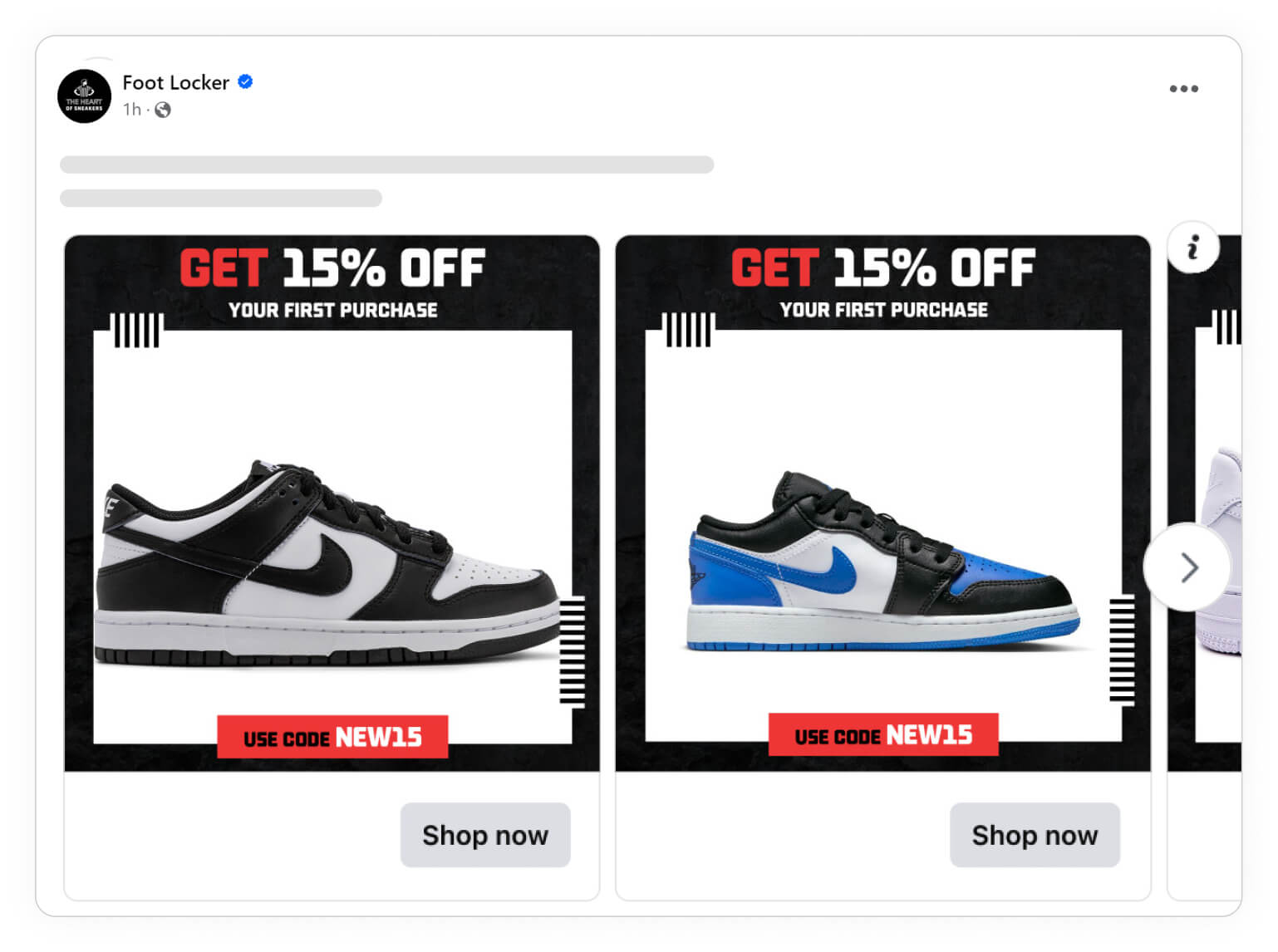
This campaign from Foot Locker isn't tied to any period of time. It could always be relevant, yet it still creates some urgency for the viewer!
The fact that it's only on the first purchase and that we have to remember and use a code to get the discount could make the viewer more likely to buy from the campaign on the spot.
.jpg)
Sometimes, it works to say it like it is. The ad basically tells us: "Hey! We are having a sale. You can save £120."
It works all the time, and everyone understands it; the only downside is that people far down the user journey will most likely buy from this Catalog Ad, as it doesn't really create any urgency at all.
The best Catalog Ads for eCommerce
We hope you can use all the inspiration & tactics in this article.
If you're still hungry for more tactics about Catalog Ads, you can always find more here at confect.io/tactics
Remember that the best Catalog Ads setups that we see are all nailing these three key areas: Always-on Catalog Ads, Campaigns & Sales, and Product-set-specific Catalog Ads.
So even though you might be a master of Catalog Ads campaigns now, there's still a lot of potential to improve your setup!
